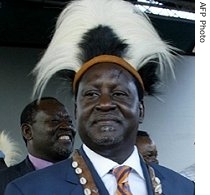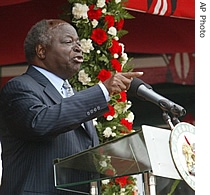2007年VOA标准英语-Kenya's Main Opposition Party Splits in Two(在线收听)
Nairobi
15 August 2007
In Kenya, a split has occurred in the main opposition party that will nominate a candidate to oppose President Mwai Kibaki in December's presidential elections. As Arjun Kohli reports from our East Africa Bureau in Nairobi, the spilt comes four months ahead of elections.
 |
| Kenya's leading opposition figure in the Orange Democratic Movement (ODM) Raila Odinga (May 2007) |
Bitter struggles to gain control of the ODM are blamed for the split.
Najib Balala, another presidential hopeful from the party, accuses Musyoka of betraying the party and says he will have to form an entirely new party to support a run for the presidency.
"One individual has betrayed the ideology that we stand for and left," he said. "If you come to the clarity of who are the reformers and who are the non-reformers and then you would know that the group of reformers are many and only one individual has withdrawn."
"I want to guarantee you that we will never allow him to run under any banner of Orange or even ODM Kenya. We are going to lock ODM Kenya in the Court and the only ODM that will be running will be our ODM," he added.
Some analysts believe that a rift will strengthen President Kibaki's chances of winning the December election.
But Kenyan lawyer and political analyst, Ojwang Agina, says voters will cast their ballots according to regional affiliations, not on ideological grounds or for parties.
He says that Kalonzo Musyoka will seek voters in many of the same regions where President Kibaki draws his strength. Far from increasing Mr. Kibaki's chances of remaining in power, Agina says the current president could now have a real competitor in his own constituencies.
"The Kalonzo canditature is hoping to capture the vote around the same area that President Kibaki expects to get votes from," he said. "That is basically Central Province. So the canditature of Kalonzo is likely to split the central Province and Eastern Province vote which President Kibaki is also eying and by so doing, lessen President Kibaki's chances of success."
 |
| Kenyan President Mwai Kibaki (Jun 2007) |
President Kibaki took over from President Daniel Arap Moi in 2002. The former president's party, KANU, has deep roots in the Kenyan countryside.
Along with the opposition ODM and the ruling NARC party, Agina says KANU will also play a role in the upcoming elections. He says the party has not nominated a presidential candidate and will likely split into sections supporting different candidates.
"Former President Moi is working to have the KANU that remains under his control to vote for President Kibaki in the next elections," Agina said. "That means that KANU as a party will be split in many different ways. Some parts of it may go to Kalonzo. Some parts of it will go to Kibaki, the one which Moi will be controlling. So that KANU element is also a major factor in the forthcoming elections."
Agina says a faction of KANU is likely to support a third candidate, Raila Odinga, from the opposition Orange Democratic Movement.
The election campaign is expected to begin in early October, several months ahead of the presidential and parliamentary elections.